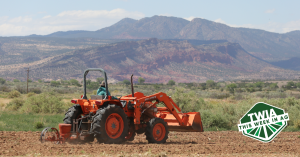This Week In Ag #122
“Don’t plan anything for the Fourth of July” were the words my mom heard every summer. It’s not like Dad didn’t want to honor that famous group of farmers who defeated the world’s greatest army, and in the process, won our nation’s independence. But being a farmer himself, he knew this was the time for the wheat harvest.
Throughout the 1900s, many Midwest farmers planted wheat, especially if they raised livestock. They wanted the straw to bed their cows and hogs. Wheat also helped with cash flow, providing a revenue source in the summer. Plus, soft red winter wheat served as an excellent cover crop while protecting the soil from erosion. Once the wheat was harvested and the straw was baled, we did something pretty innovative in our area for the time: we immediately planted soybeans. We called it double cropping. In the South, they call it growing wheat beans. In the 1970s and 80s, with the genetics we had available, we were thrilled if our double-cropped soybeans yielded 25 bushels per acre, as July rains can be scarce while heat stress is high. These multiple crops often provided a nice per-acre revenue.
The practice of double cropping looked to make a return a few years ago, when prices for both crops hit historical highs, but that has since cooled off. But double cropping isn’t the only flexible farming system for wheat. Many wheat acres, especially across the southern Plains, are utilized as wheat pasture, meaning they are grazed by cattle.
Later in the Awesome 80s, as meat packers and crop rotation started disappearing across the Cornbelt, so did the presence of wheat. Corn/soybean-friendly Farm Bills and biotech breakthroughs focusing on the big two commodity crops, plus global competition, also contributed to wheat’s slide. Since its peak in 1981, total wheat acres have dropped by half. US wheat acres now stand at about 45 million acres. Keep in mind that the wheat grown in the Midwest and South, where it’s still common, differs from the amber waves of grain found across the Great Plains. The soft red winter wheat commonly grown in the east is higher in starch and used for cake flour. Hard wheat is used to make breads, like the buns you’ll be using for your Fourth of July hamburgers and hot dogs.
Whenever I think of wheat harvest, I recall 1980, when prices were near historic highs and an elevator across our county was offering a premium. I was just 13 at the time and was driving loads to the elevator in our 2-ton C-60 grain truck. I was taking back roads, even though Uncle Gary encouraged me to take the main highway like he was, saying it was a lot faster. That afternoon, he may have beaten me to the elevator, but he didn’t beat me back. That’s because the Illinois State Police set up portable scales outside of town. And he got stopped. Like both dad and Uncle Gary tended to do when loading trucks, his truck was filled well over the legal hauling limit. Let’s just say the ticket he got offset the premium received from the elevator.
Related Posts

This Week in Ag #67
Last week, I had the honor of helping my Native American friends from the Zia Pueblo in New Mexico plant corn on their tribal land. Every farm has its limiting factors, and for the Zia Pueblo the most prevalent is water. While I’m doing furrow irrigation on my Tennessee farm to utilize and manage our

Huma Gro® Fertilizer Products Increase Cucumber Yields at ROI of 113%
The Huma Gro® fertilizer treatment increased the cucumber yield by 2% (8 bushels per acre) over the Check, with a return on investment (ROI) of 113%.

It’s ALIVE!
by Heather Jennings, PE . . . the lagoon sludge layer, that is. I’ve seen many lagoons full of sludge, and the general attitude I find in the water industry is that the sludge layer is inert and really can only be mechanically dredged. To a certain point, that is correct: sand, soil, grit, plastics—basically

